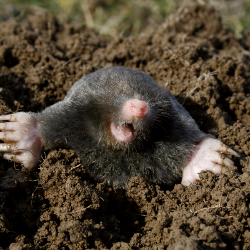Garden Mole Control & Molecatcher Services in West London
Research suggests that the mole population in the British Isles has been soaring since 2011, as the direct result of two influencing factors:
- Hot, wet summers are encouraging the mole to breed
- The ban on strychnine hydrochloride in 2006 has affected farmers and landowners across the UK who would have, at one time, poisoned the moles themselves



How much you do you know about the secretive, underground mole?
You, of course, can tell immediately if you have a mole frequenting you prized bowling green, lawn or country estate for, scattered across the vast green surface will be several molehills. This causes people anxiety, with the landscaped ruined by the lumps of soil but also for the fact that many molehills essentially means there is a vast tunnel network just below the surface, weak or unstable pockets of land, with livestock or heavy machinery trundling across it can causing it to give way underneath.
But the mole is a secretive creature, rarely seen unless trapped but there are many interesting facts about the mole…
- Many people assume it is black in colour, but the mole can also be a silvery grey
- They do not hibernate, continuing their tunnelling escapades all year round
- They have sensory hairs all over the head and behind their small years that allow them to detect any vibration or movement close by them; this is the way they detect food such as earthworms
- Moles are virtually blind, detecting only the difference between dark and light
- Their hearing, however, is brilliant!
- The female has one litter a year, with normal litters number between 3 and 4 young
- They breed between February and June, with the young fully matured by 5 weeks
- Moles can live for up to 5 years
- Moles will share some common pathways but will defend their inner territory from other moles, which is why they mark their tunnels with a scent from their urinary tract – this is also how they identify themselves during the breeding season
- When a mole does vacate their tunnel, another one will move in…
Getting rid of moles
Knowing moles and their habits is important when it comes to getting rid of moles.
Their tunnels, for example, can be far more extensive than what many people think. Beneath the shallower tunnels just below the surface, lays a network of deeper, larger tunnels, all with compartments for different activities. Moles are excellent swimmers too, therefore can be found in areas where the water table is high, although some experts suggest that sandy soil is preferred as digging tunnels is far easier.
Moles feed mainly on earthworms and molluscs, with their sleeping and work pattern being in a cycle of 4 hours; when food is plentiful, biting the head off worms and storing them for later consumption is a way of moles stockpiling food.
The control and eradication of moles can be controversial as some people assume that they do little damage but, like all wild animals, maintaining population numbers of moles is important in maintaining the countryside and land.
There are different ways of controlling moles as well as encouraging them to move elsewhere.
- Mole traps – these are considered humane control methods if used properly but what can happen is that the mole is not always killed outright. Like all pest control issues, consulting a professional control expert is the only clear, humane solution to dealing with all pests. Likewise, with traps, you need to have an idea of the habits of moles in order to place the traps in the right place, at the right time…
- Electronic devices – these are also sold in various stores, as well as online and are said to work by sending an inaudible buzzing noise to use humans, but is one that annoys the mole. This disturbance encourages it to leave; results are mixed.
- Repellents – these repellents work by repelling the moles food sources (mainly worms) so that the mole is encouraged away from the area; again, the results can be mixed.
- Planting – moles are not keen on some plants, and so creating a border full of alliums and caper spurge could be an additional deterrent.
However, all these actions are futile unless you ensure that the access to the mole tunnels are blocked off as once these ‘repellents’ have served their usefulness, within a short time another mole could be occupying these tunnels.
The solution to any mole problem is to call on the professional and expert services of a pest control technician. Using only humane methods, results for eradication and control of any pest, including moles, are more or less guaranteed… why waste time and money on anything else?








 for W areas
for W areas





